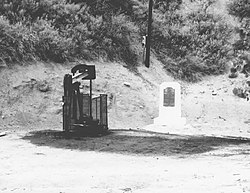Pico Canyon Oilfield
|
Well No. 4, Pico Canyon Oil Field
|
|

Well Number 4 in 1961, Pico Canyon Oil Field
|
|
| Nearest city | Newhall, California |
|---|---|
| Coordinates | 34°22′10″N 118°37′49″W / 34.36944°N 118.63028°WCoordinates: 34°22′10″N 118°37′49″W / 34.36944°N 118.63028°W |
| Area | 850 acres (340 ha) |
| Built | 1876 |
| NRHP Reference # | 66000212 |
| CHISL # | 516 |
| Significant dates | |
| Added to NRHP | November 13, 1966 |
| Designated NHL | November 13, 1966 |
Well No. 4, Pico Canyon Oilfield, located about seven miles (11 km) west of Newhall, California, in the Santa Susana Mountains, was the first commercially successful oil well in the Western United States and is considered the birthplace of California's oil industry. Drilled in 1876, it turned nearby Newhall into a boomtown and also spawned a smaller boomtown called Mentryville adjacent to the drilling site. Well No. 4 continued in operation for 114 years until it was capped in 1990. The site was designated a National Historic Landmark in 1966, and the Mentryville ghost town is now open to the public as a historic park.
Following the oil strike at Drake Oil Well in Pennsylvania in 1859, there was a short-lived oil drilling boom in California, but this was wiped out in 1867 when eastern oil could be sold cheaper. At the end of the first boom, 75 companies had drilled 60 wells in California, spending $1 million to produce $60,000 worth of oil.
Oil seep locations, in present-day Pico Canyon area of the northern Santa Susana Mountains, were known and used for centuries by the local Tataviam and Tongva Native Americans for medicinal and healing purposes. Various accounts exist about the Spanish-Mexican era rediscovery by non-indigenous people of oil in Pico Canyon. Some accounts credit Andrés Pico with discovering oil there in the 1850s, but the Los Angeles Times reported in 1882 as follows:
"The Pico Oil Spring was discovered in January, 1865, by Ramon Peria, a Mexican hunter. One day while hunting for deer he wounded a buck. He followed the trail and found it dead near the spring. The quality of the oil in the spring attracted his attention, being of a dark, green color and very thin, and so different from anything that he had ever seen, that he concluded it must be valuable. So he notified a friend of his, Jesus Hernandez, and they located the oil claim."
According to a later account, Peria gathered some of the oil in his canteen and brought it to others who recognized its value. Yet another account indicates that Perea brought a small amount of the curious substance to the Mission San Fernando, where a Dr. Gelsich recognized it as petroleum and at once formed a company to stake out claims. Perea was granted an ownership interest in an oil company for making the discovery, but he reportedly traded his interest in the company for a barrel of spirits and a $20 gold piece. After the discovery, claims were staked out, but it was not until almost five years later that the first well was struck and later still before the first commercial success.
...
Wikipedia



